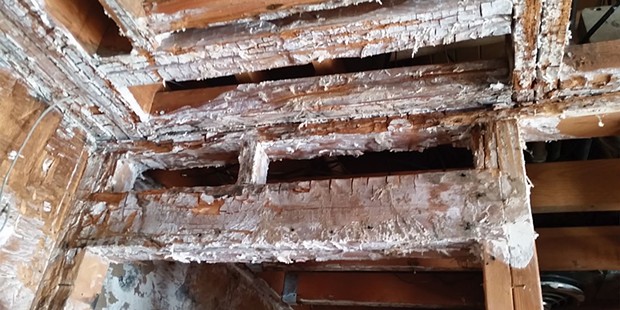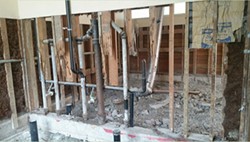Mold School
Klamath-Trinity's massive campus mold cleanup
By Grant Scott-Goforth [email protected] @GScottGoforth[
{
"name": "Top Stories Video Pair",
"insertPoint": "7",
"component": "17087298",
"parentWrapperClass": "fdn-ads-inline-content-block",
"requiredCountToDisplay": "1"
}
]
A mold epidemic has struck schools from Hoopa to Pecwan, shuttering classrooms and cafeterias, shuffling kids into less-than-ideal temporary rooms, prompting impromptu days off and sparking a multi-million-dollar repair project.
Jon Ray, the superintendent of the Klamath Trinity Joint Unified School District, which oversees eight schools spread over 1,000 square miles, including Hoopa high school and elementary, and others in the Klamath and Trinity river region, said he thinks the mold problems may have been serious enough to affect the district's attendance rates.
Children and people with respiratory disease are especially susceptible to mold, which can cause a host of symptoms like congestion and fatigue.
The district closed all of its schools for five days in February, having discovered widespread mold. For that and the following week — which was a regularly scheduled vacation week — teachers and staff scrambled to rearrange campuses. Sixteen classrooms were closed in total, as well as cafeterias and kitchens in four schools, and libraries and administrative offices.
Seventh and eighth graders at Hoopa Valley Elementary were moved into rooms at Hoopa Valley High School; students at a community day school were moved to another facility; libraries, computer labs, conference rooms and other facilities were adapted to make room for students. Since the closure, two schools have been feeding students out of a rented portable trailer.
"It is by no means optimal," Ray said.
But the district hasn't just relocated the students, 90 percent of whom are Native American and qualify for the district's free lunch program. Last month the State Allocation Board — with guidance from North Coast Sen. Mike McGuire — gave the school district nearly $10 million, which the district has already awarded in abatement contracts. Demolition of the mold-damaged properties has begun. Contracts to repair — or rebuild, as needed — are being solidified this month.
The district's mold problem dates back to the poor design of its buildings — mostly built in the 1950s and 1960s — for the humid North Coast climate, Ray said. Insulation and other materials absorb water from leaks, which cause the mold to proliferate. As it spreads, it can damage the structural integrity of load-bearing beams and studs.
Ray said the cafeterias are expected to re-open by Aug. 31 — two days into the school year. The other construction under the "aggressive building plan" is scheduled to finish in November, though Ray concedes it could take longer, depending on what structural damage is discovered as crews peel off moldy drywall. The repairs also include Americans with Disabilities Act upgrades, like widened doorways, and plumbing and electrical reroutes could delay those improvements, he said.
Construction on the KTJUSD's facilities is pricey as well. Specialists, workers and materials have to come from the Redding or Eureka areas, increasing the costs to the district by 35 to 40 percent, Ray said.
While the district is deep in the throes of repairs now, it's not a new problem. Mold can grow quickly, but the scale of the problem at KTJUSD schools shows it's been growing for years. "That doesn't happen overnight," Ray said. "Unfortunately, I think people in Humboldt County are kind of used to mold or real moisture-ridden rooms."
In fact, the recent round of repairs is part of what Ray called "Phase Two." The district first began addressing mold problems in April of 2014, closing classrooms and Hoopa Valley High's gymnasium, which is scheduled to re-open this summer.
The district funded the first phase of repairs with $15.7 million from two certificates of participation — essentially mortgages issued on the district's properties, which the district pays back to the lenders. Ray said those protect against repossession to a certain degree — if the district defaults, the lenders could take ownership of the property but would have to continue to rent it to the district.
The money recently granted by the State Allocation Board was intended to be reimbursement for the first phase of the mold abatement project, but Ray said those funds will now be put toward phase two. The district will apply again for reimbursement, and has put a bond measure seeking $6.5 million on the June ballot. Those bonds can't be larger, Ray said, because 75 percent of the school district's lands are tribal — which means they can't tax the properties on them.
The district will also seek federal grant money that helps districts on untaxable lands, but there's little in that pot to go around, Ray said.
The district has also applied for a waiver for the five days of instruction students missed in February, which Ray says he's confident it will receive. Because the district paid faculty and staff while no students were present — moving the classrooms was an all-hands-on-deck situation — it would have to find funds to pay them if the missed instruction days were added on to the end of the school year.
In the end, the repairs and construction should make KTJUSD's facilities safer and more comfortable for students and staff.
Mold is a common problem on the North Coast and can cause symptoms similar to allergies: congestion, sneezing, sore throat, coughing, shortness of breath, skin irritation, headaches and fatigue, according to the California Department of Public Health.
Children and people with respiratory problems or who are allergic to mold can be more susceptible to those problems. Certain kinds of mold produce toxic compounds, which can further exacerbate these conditions.
But the Department of Public Health makes no distinction between toxic mold and more benign strains because they can all cause health problems. "It is not necessary to know if toxins are present to take appropriate action and remove molds," the department website states.
Ray said his district has lower attendance rates — and therefore lower rates of academic achievement — than Humboldt County or state averages. And he thinks that might be partly because of the district's widespread mold problems. Students might be staying home from school because they're sick, he said.
In addition to mold-free rooms, the repaired classrooms will have improved circulation, heating and air conditioning. The improvements may help prevent mold from growing in the future, but they'll also make for a more comfortable learning environment for kids, he said. "When it gets real hot, it's hard to sit in a classroom of 25 middle school kids who are sweaty and stinky."
With classrooms, cafeterias and gyms set to be repaired by the end of this year, Klamath-Trinity students could be in store for a healthier, happier and more productive school year.
Comments (6)
Showing 1-6 of 6
more from the author
-
Flamin' Hot's Stale Corporate Propaganda
- Jun 15, 2023
-
Hell is Visiting Other People
- Sep 22, 2022
-
The Bear Roars
- Aug 18, 2022
- More »
Latest in News
Readers also liked…
-
Through Mark Larson's Lens
A local photographer's favorite images of 2022 in Humboldt
- Jan 5, 2023
-
'To Celebrate Our Sovereignty'
Yurok Tribe to host gathering honoring 'ultimate river warrior' on the anniversary of the U.S. Supreme Court ruling that changed everything
- Jun 8, 2023



































